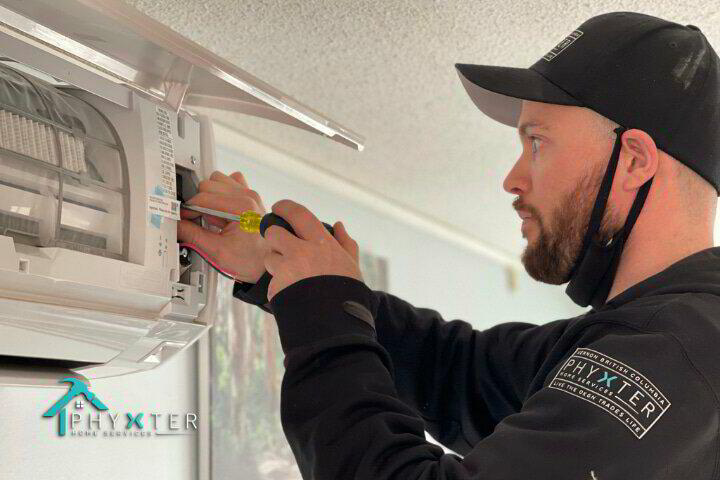Table of Contents
When it comes to home DIY air conditioner repair, you need to make sure you have the right tools, the right parts, and the knowledge of how to troubleshoot service failures, and you need to be extremely safe.
If you are missing any of these things, then you should hire a licensed and local HVAC contractor to repair your air conditioner.
Remember that you will need tools and should be comfortable using them.
Repairing air conditioning units can be dangerous, so if you’re not comfortable, you should look into hiring a licensed and local HVAC contractor.
Sometimes it’s necessary as the repair may require the use of specialty tools that can be expensive for a homeowner.
If you’re looking into getting more out of your home through DIY, you will need the right tools.
As a professional contractor, nothing speeds up a job like using power tools. But what are the right ones?
We have a great article on the best power tool brands for 2024 if you want to check it out.
🛠️ You Will Need Some Tools to Get Started.
- 1/4″ nut driver
- Voltage tester or CAT III Multimeter
- Insulated screwdriver set
- Socket set
- Pliers, needle nose will work the best
- Cordless drill
- Adjustable wrench
- You may also need slip-joint pliers (commonly referred to as channel locks)
🛠️ Here is a List of Required Parts and Materials You Will Need
- Capacitor (you’ll need to know your air conditioning unit model and serial number to order this)
- A water hose and/or compressed air
- Condenser fan motor (you’ll need to know your unit model and serial number to order this)
- Contactor (you’ll need to know your unit model and serial number to order this)
- Fuses (or a circuit breaker in some cases)
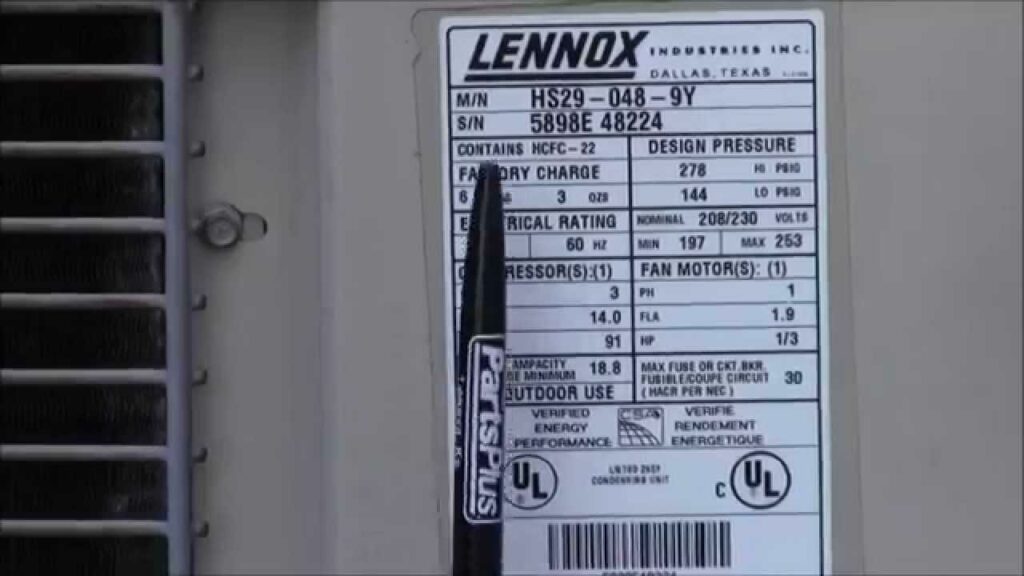
⭐ How to DIY Service Repair Your Home Central Air Conditioner System:
🛠️ Service Failures and Solutions.
It’s the middle of July, the hottest time of day, and your air conditioner stops working; what are your options?
You can hire a licensed HVAC contractor or an air conditioning systems repair company.
Or if you consider yourself handy and have the tools, then you could save yourself a few hundred bucks and repair your air conditioning system yourself.
Keep in mind that you’ll be working around high-pressure refrigerant and electricity so if you’re not comfortable with it, you should err on the side of caution and use Phyxter to connect with a local contractor.
I spent years as a licensed air conditioning journeyman, and I’ve worked on cooling systems as small as a window unit to as large as 6,000-ton chillers.
During my time as an HVAC technician, I worked in Canada, the U.S., Mexico, Australia, Chile, and Mauritania (you may need to Google that one).
From that experience, I will try and give you my best tips to get your air conditioning up and running safely and at a low cost.
I’m only going to cover common cooling system failures, so if something related to the refrigerant system needs to be repaired, you will need to call a contractor.
⭐ Why isn’t my AC Cooling My Home?
You’ll need to start by making sure your furnace isn’t the issue.
Let’s start by ensuring your thermostat and your furnace (or air handler) are working correctly.
First, you will set your thermostat to cool and turn the indoor temperature down to make sure that it’s “calling” for the A/C to turn on.
Give it a few minutes, and then check to see that the fan in the furnace is running and blowing air throughout your home.
If the fan in the furnace isn’t running, then turn the furnace off at the breaker box, wait a couple of minutes, then turn the breaker back on and wait five more minutes to see if the blower fan turns on.
If the fan doesn’t turn on, then the problem is in the furnace or the thermostat, and you’ll need to read a different help article.
If it does turn on, then you’ve confirmed that the problem is in your air conditioner.
For more information about troubleshooting thermostat problems, check out: Thermostat Not Working? Read our Quick Fix It Guide!
🛑 Caution: Turn the Power Off!
Remember that before you open any panels to your furnace or air conditioner, you should turn off the power!
Related Reading: What Is The Best AC Temperature for Summer
⭐ My AC Doesn’t Work. How Do I Figure Out What’s Wrong?
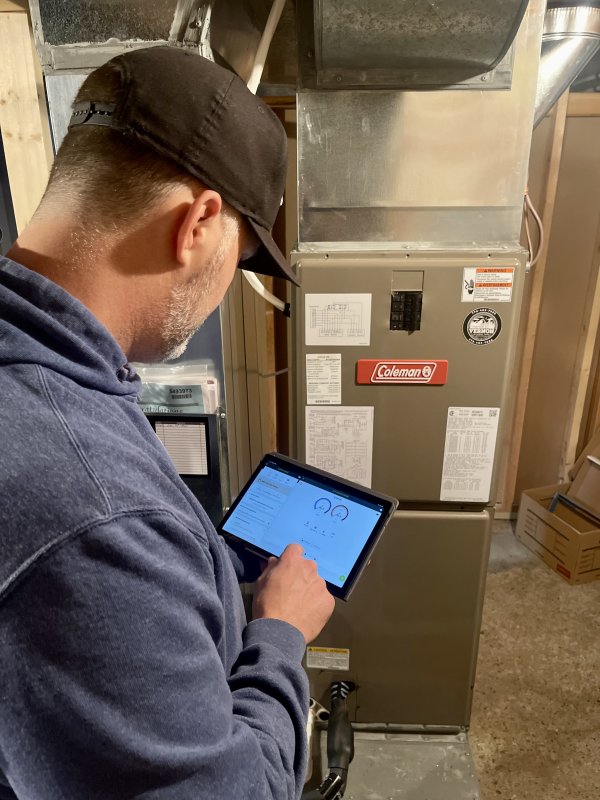
Multiple things could go wrong with central air conditioners, so I will walk you through my air conditioner troubleshooting process, starting with the most common causes of failure and working towards some more complex but easy-to-repair issues.
🔧 Reason 1: Plugged air filters or evaporator coil
🔧 Reason 2: Lack of return air
🔧 Reason 3: Plugged condenser coil
🔧 Reason 4: Failed condenser fan
🔧 Reason 5: Failed capacitor
🔧 Reason 6: Failed contactor
⭐ Air Conditioner Component Names and Locations
Before we review each of the above “Reasons,” you will need to know what major components look like and where they are located.
The image below will help you to troubleshoot your air conditioner repair, so keep it handy.
It’s not cut and dry, so; you must understand which components are the most important to your cooling system and usually the most expensive to replace.
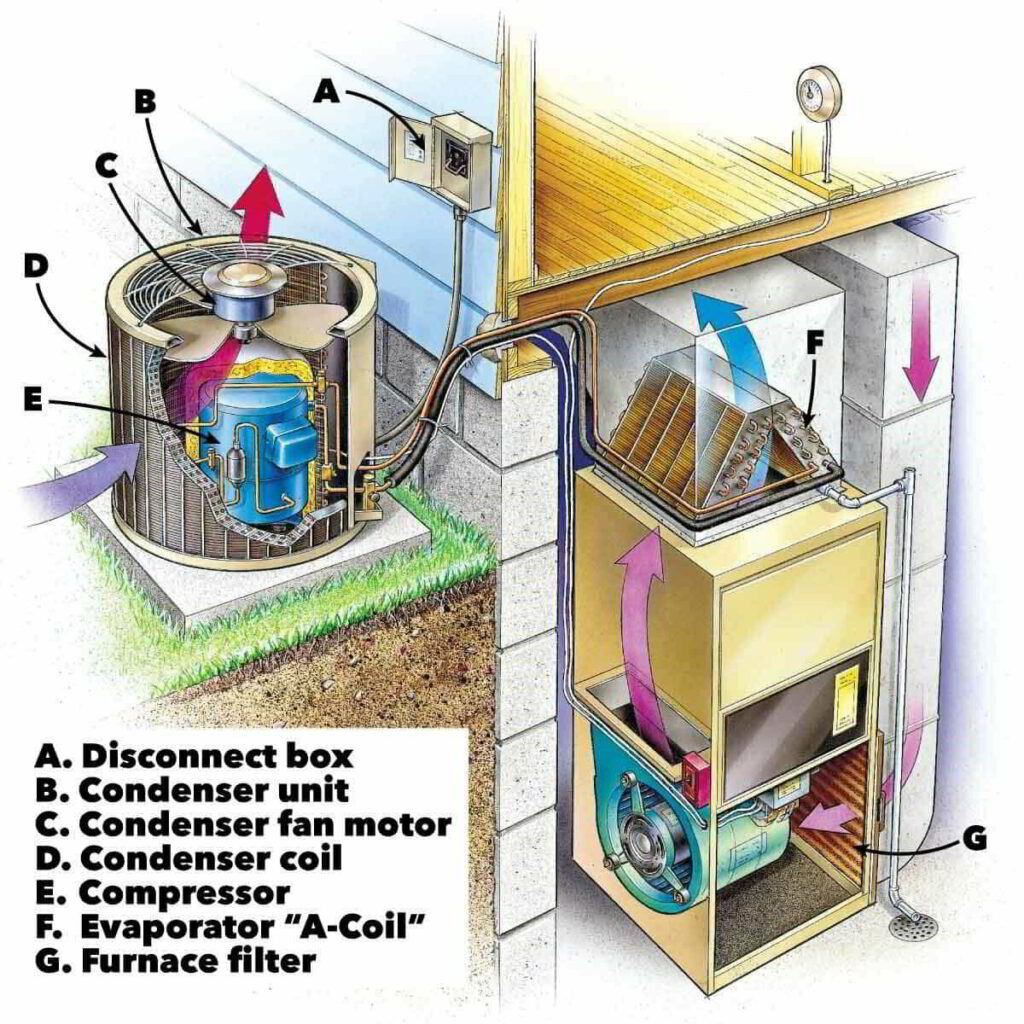
⭐ Start Troubleshooting Your DIY Air Conditioner Service Repair
🛠️ Reason 1: Plugged Air Filters or Evaporator Coil
This has to be the cause of 90% of the furnace and air conditioning service calls; a plugged filter.
If you have cats or dogs, there is probably a 99% chance it’s the issue. This is the number one reason we get service calls during the cooling season!
A clogged filter reduces the amount of airflow through the AC and significantly reduces your system’s efficiency.
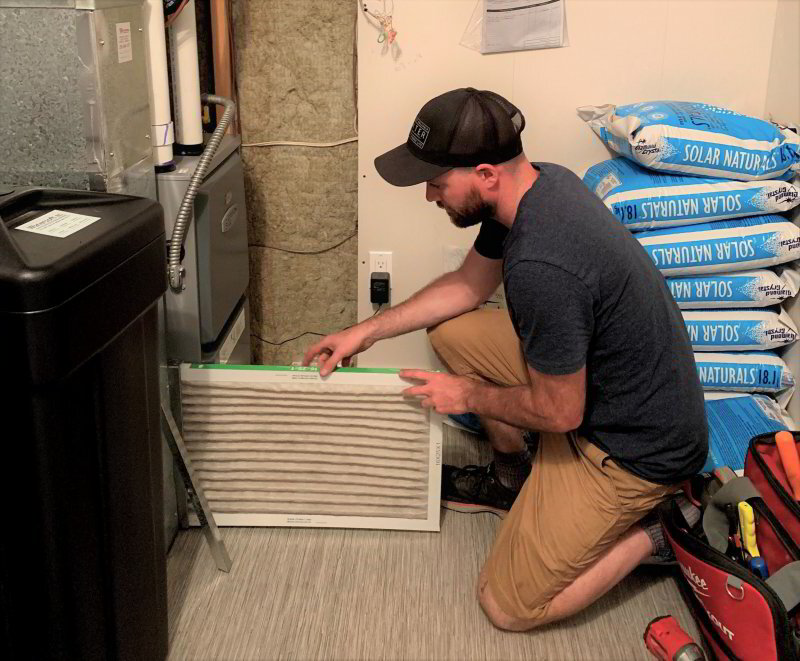
🛠️ How to Change your Furnace or AC Air Filter
What you will need to do is shut the power off to the furnace or air handler, find the air filter location, pull it out and then go and purchase a new filter that is the same size and rating (the old filter will have the details you need printed on it).
When you replace the filter you need to make sure that the arrow that’s printed on the filter is pointing in the right direction (don’t trust the way it was installed before, it needs to be pointing in the direction that the air is flowing; usually pointing towards the furnace).
After the air filter is installed, you can turn the furnace power back on and go back to the start of the article to restart the AC testing procedure.
You may have solved your airflow issue, but there could be a residual issue that was caused and which will need time to repair itself.
🛠️ How to Fix Frozen AC Evaporator Coils
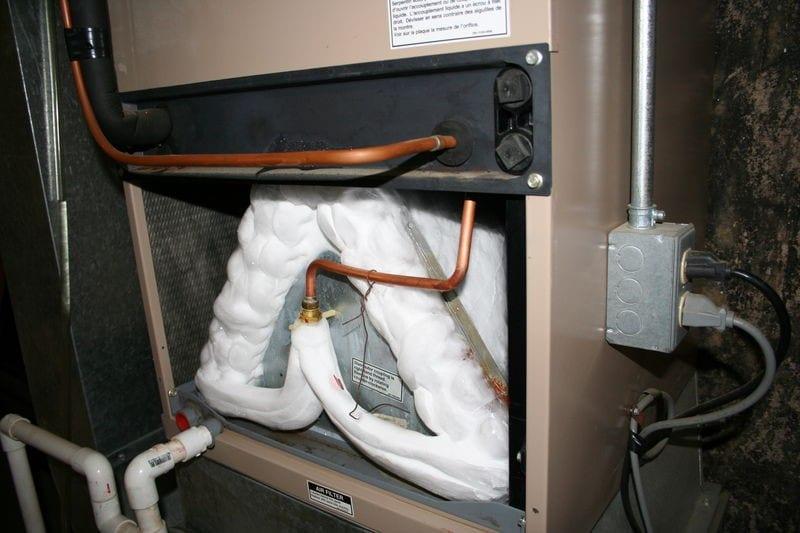
⌚ Time!
The easiest way, but not the most convenient, is by waiting and letting it thaw out.
Unfortunately, the most likely reason it froze was that your air filter was plugged, and it couldn’t get air to absorb heat, so the coil’s temperature kept dropping and eventually froze into a block of ice.
It will need to be completely thawed before you can restart your AC; if you restart your AC too soon, you’ll risk freezing it up again.
If you want to speed up the process, you can do one of a few things: set your thermostat to have the AC off but the fan on.
This will keep the furnace fan running and blowing warm air over the coil.
Of course, you could also try the old hairdryer trick, but why stand there for an hour when you could just run your fan.
If you really want to speed it up, you could set your thermostat to heat mode and turn the temperature setting up…but this isn’t recommended because your heat exchanger won’t be getting proper airflow, which could cause issues when it comes to your furnace life.
👍 My recommendation: Turn the fan on and let it run until you feel warm air coming out of your home’s floor vents.
🛠️ Reason 2: Lack of Return Air
This one can be difficult to find the root cause, but that’s because it is literally hiding from you.
The evaporator coil, which is the indoor component of your HVAC system, usually located above your furnace, needs airflow to absorb heat from the air, and if it doesn’t get that airflow, it will freeze up and stop working.
The first place you checked was the filter, but it’s okay, so what next.
Your home’s forced-air system has two types of vents, discharge vents and return air vents.
For our troubleshooting purposes, I’ll explain the return air vents.
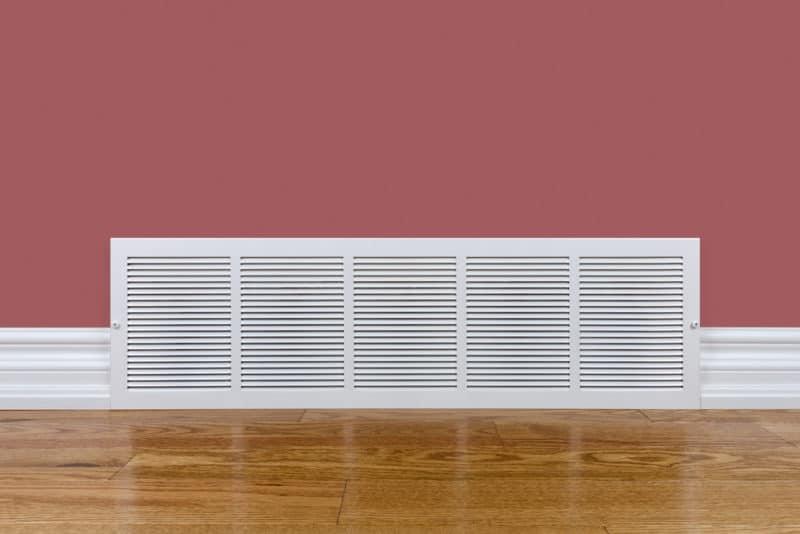
The above image shows that the vent is on the wall, but it can also be on the floor.
They are larger than the discharge vents and are usually dirtier.
They’re dirtier because they suck air into the system, whereas the discharge vents blow it out after it’s been filtered at the furnace.
You need to make sure that none of the vents are blocked or covered, whether it’s a door, boxes, or just that they’re covered in dust and grime…
They need to be clear because your entire system was designed to have a certain volume of air in and a certain quantity of air out.
If your furnace or air conditioning doesn’t get that volume of air, then they won’t work correctly and may fail.
🛠️ Reason 3: Plugged Condenser Coils
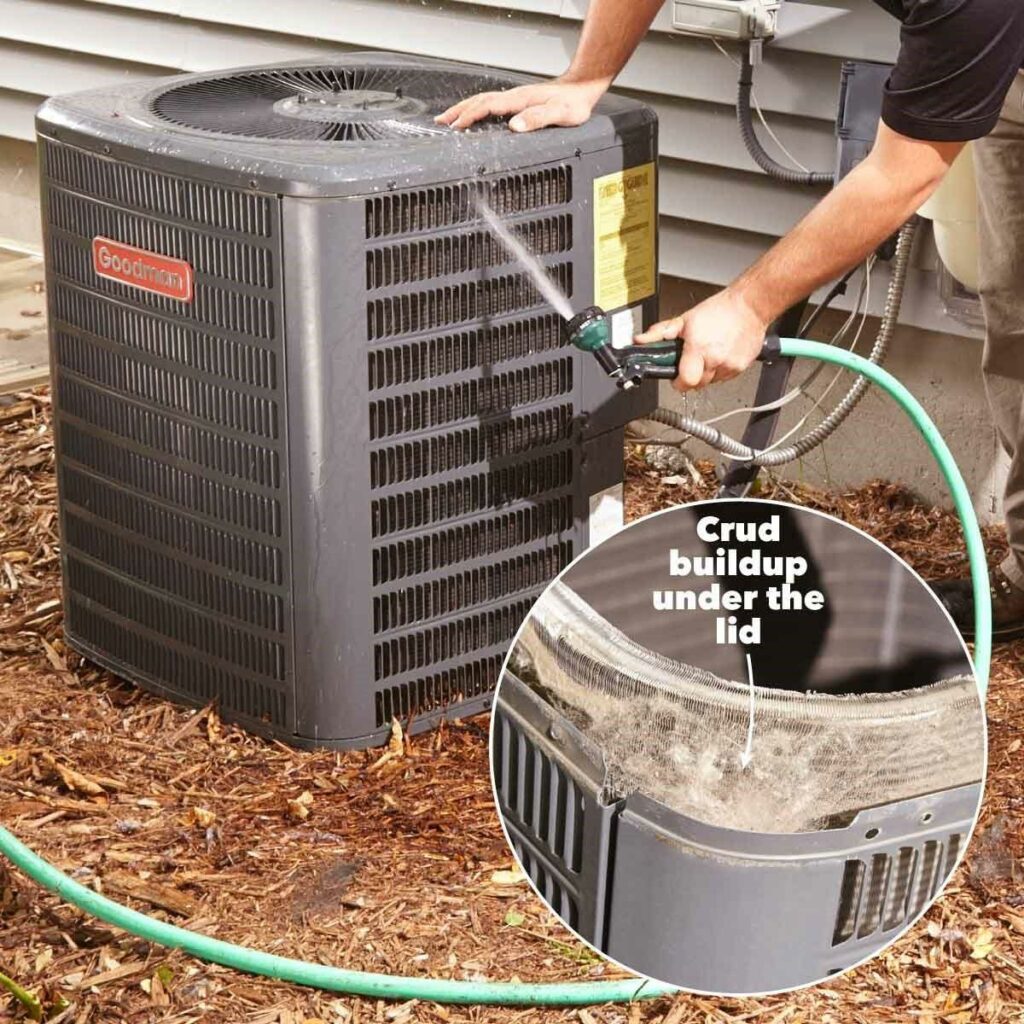
If you’ve made it this far, you’re not only getting close to figuring out the problem with your air conditioning system, but you’re also ensuring that it will be working more efficiently moving forward.
Because your A/C system is the biggest consumer of energy in your home, you’ll now be saving money.
Ok, so let’s check to see if you’re condenser coils are plugged.
If you’ve never cleaned it like what’s happening in the above photo, then it’s at least dirty and does need to be cleaned, so let’s do that now.
Caution: Make sure the power is off to the outdoor condensing unit
Now that the power is off, you can get your water hose or compressed air (I prefer water because it’s safer and easier).
When you hose down the outdoor coil, you’ll need to point the spray straight at the coil and not at an angle.
If you bend the coil fins, you’ll do more damage than good.
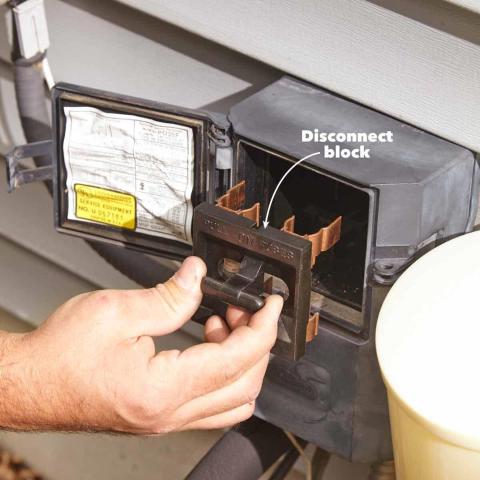
Once the AC condenser coils are clean, you can go back to the start of the article and start testing again.
If the system starts correctly, the outdoor fan will be running, and you’ll be able to hear the compressor running as well (it kind of sounds like a loud refrigerator, any louder you have a problem).
You can also wait to see how the air feels coming out of your discharge air vents (if you have a temperature gauge, the air coming out of the vents should be approximately 20 degrees cooler than the air going into your return air vents).
If your AC still isn’t running, then we’ll need to move on to step 4 – a failed condenser fan.
🛠️ Reason 4: Failed Condenser Fan
This one could be considered simple to figure out, but the repair is more complicated than the previous air conditioning repairs…you’ll need to get your tools out for this.
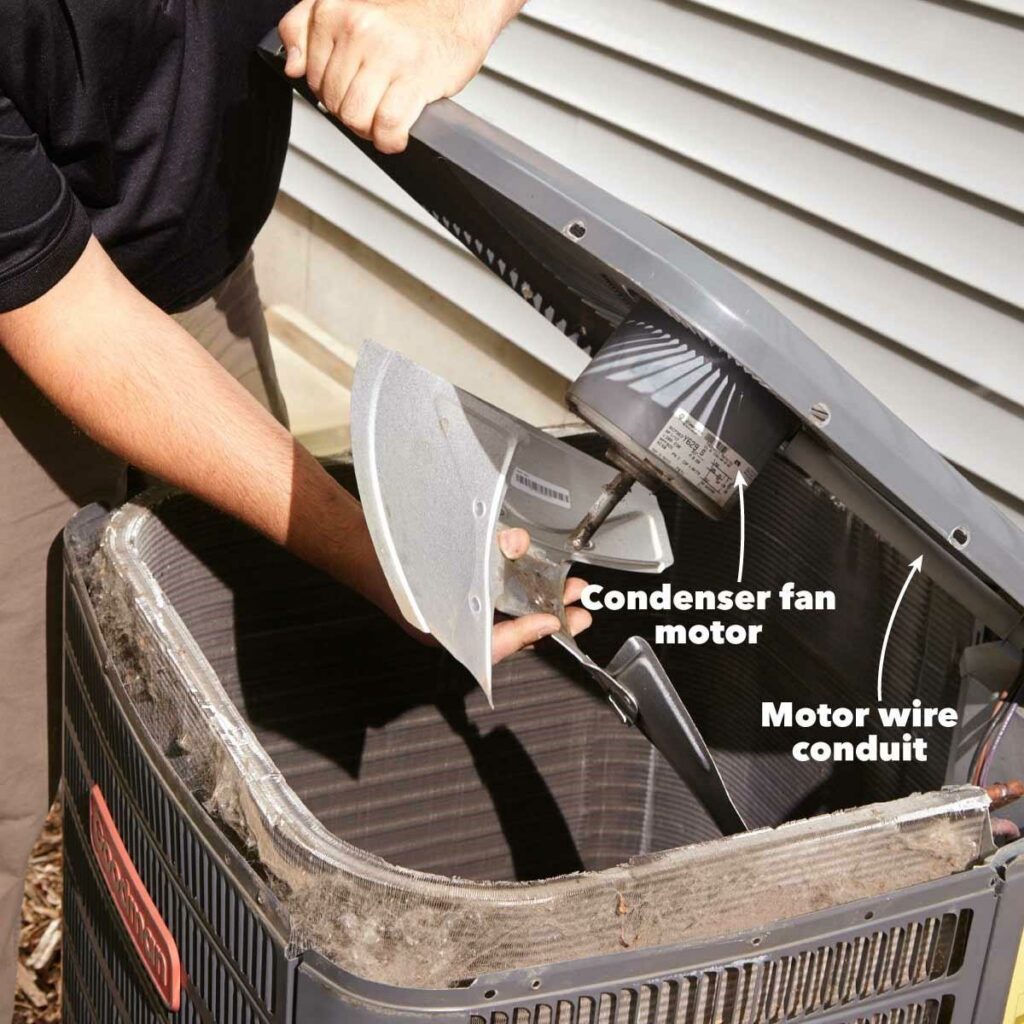
First, let’s determine if the condenser fan has failed.
Next, you need to make sure that your thermostat is set to cool and that the temperature setting is turned down, and that you’ve turned the power back on for your furnace and your outdoor unit; then, you need to confirm that the outdoor unit is getting the control signal.
There are a couple of ways to do this; you could take off the control panel on the condensing unit (which you may need to do later anyway) and use your multimeter to confirm that contactor is getting “pulled in.” If it is, you’ll have around 24 volts across the contactor
(See the video below for a detailed description).
Let’s assume that the contactor works and that the condenser fan isn’t running.
If this is the case, the compressor will cycle on and off a few times until the control board recognizes a problem and locks the unit out.
Ok, let’s change the condenser fan motor.
You’ll need to turn the power off to the outdoor condenser unit at the breaker, as seen above, under CAUTION.
Then you’ll need your screwdrivers or nut drivers to remove the unit’s cover; you’ll need to disconnect the motor from the cover, remove the fan blade from the motor shaft, and install the new motor with the old fan blade (unless the new motor came with it).
As a side note, I generally recommend replacing the fan blade as well; it can be tough to get off the old shaft, especially if you don’t have the right tools.
When reconnecting the new fan motor’s power cables, you’ll want to follow the wiring diagram strictly. If you’re not comfortable reading a wiring diagram, then you shouldn’t be performing this step.
Now let’s turn the unit’s power on again and see if it starts.
Great! The fan is running!
It’s still running…it won’t stop running!
Ok, on to the next potential issue. Now we’ll look at changing the capacitor.
🛠️ Reason 5: Failed Capacitor
The contactor is pulled in, as per the above explanation and video tutorial, but the condenser fan and compressor aren’t running, so it could be a blown AC capacitor.
Here’s what you’ll need to do to replace the capacitor.
How to discharge a dual start/run capacitor
Remove the capacitor from the retaining bracket, and then take an insulated screwdriver and touch it between the COMMON (or “C”) terminal and the HERM (or “H”) terminal.
Do the same between the “C” terminal and the FAN (or “F”) terminal. For single-mode capacitors, all you need to do is create a short between the two terminals.
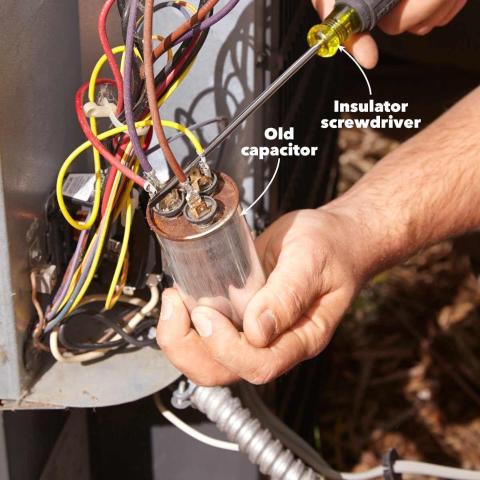
How to Replace a Dual Start/ Run Capacitor
Every air conditioning service unit has at least one capacitor.
If you’re wondering what a capacitor does, it stores electricity and releases it during compressor and condenser fan startup to give both motors a boost of power.
It also helps to smooth out voltage fluctuations from the grid, protecting the motors from getting damaged.
As capacitors fail over time, they cause the motors in the compressor and condenser fan to work harder than they were designed.
This additional work decreases their lifespan and causes them to fail earlier than expected.
Since capacitors are relatively inexpensive, my recommendation is to replace them every 3-5 years.
To replace them, take a photo of the current capacitor’s wires, discharge the capacitor, and then install the new one.
This is where you’ll need to use your insulated screwdriver and needle-nose pliers.
🛑 Caution: Make sure to discharge the capacitor before removing it.
Capacitors hold a large electric charge even after they’ve been removed from power.
🛠️ Reason 6: Failed Contactor
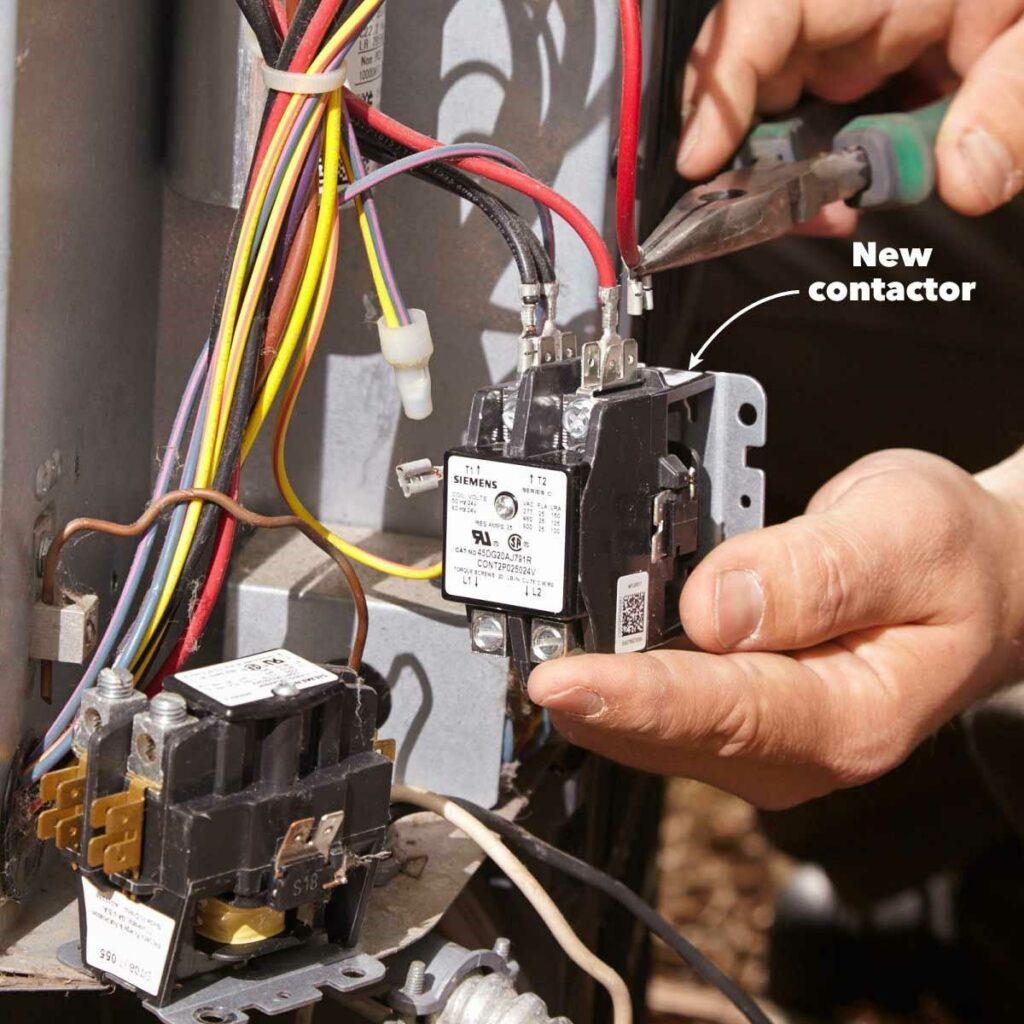
🛠️ How to Replace a Failed AC Contactor
Let’s perform this procedure step-by-step.
First things first, make sure the power is turned off at the breaker and test that it’s turned off with your multimeter (watch the video below if you don’t know how to test for power with a multimeter).
After confirming that the power is off, take a few photos of the wires that are connected to the contractor and then disconnect the wires, install the new contractor, and reconnect the wires.
Confirm that all of the wires are correctly connected, and then turn the power back on to test your AC.
If you want to confirm that your contactor is faulty, you can do that by testing the 24v coil; it is what pulls the contacts in and allows the power to flow through the contactor.
Basically, the thermostat sends the signal to the AC condensing unit contactor coil; the coil energizes, creates a magnetic field, pulls the contactor down to close the circuit, and allows the 240 volts to flow through to the compressor and condenser fan.
If you have 24 volts going to the coil, but the coil isn’t pulled down, then the coil is faulty, and the contactor needs replaced.
You can also check the 24v coil using an ohmmeter to check for continuity (that there are no breaks in the coil).
If the ohmmeter reads open (or infinite), then the coil is faulty and needs to be replaced. You can also watch this video for a tutorial on how to troubleshoot an air conditioner contactor.
Remember, if you’re ever uncomfortable testing electricity (and you should be uncomfortable), then you should call your local and reliable HVAC contracting company to come out and fix it!
⭐ Air Conditioning Repair Summary
We’ve given you a solid overview of repairing the primary issues that plague air conditioners when they don’t start up.
If you still have issues fixing your AC or don’t feel comfortable with some of the repairs listed, especially anything related to electricity. You should contact your local HVAC contractor.
If you live in the Okanagan region, give Phyxter Home Services a call.
We have offices in Vernon and Kelowna. We take pride in doing the work right the first time, every time.
So, whether it’s professional maintenance, an air conditioning repair or a replacement, our technicians have the skills and experience to get your AC system working quietly and efficiently to ensure you and your family are comfortable.
We can also hook you up with a new air conditioner with better energy efficiency than your last one, saving you money in the long run!
Dealing with other common AC problems? Check out: Top 18 Common AC Problems and Solutions.

